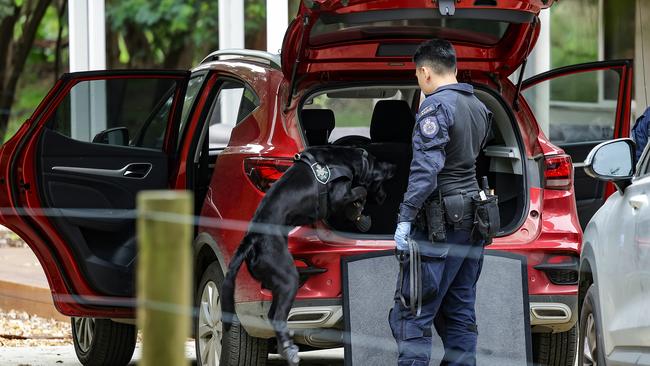Police use tech dogs to investigate mushrooms deaths
Erin Patterson apparently likes dogs but not necessarily those the AFP brought to the country quiet of Gibson St, Leongatha, shortly after 8am.

Erin Patterson apparently likes dogs but not necessarily the black labradors the Australian Federal Police brought to the country quiet of Gibson Street, Leongatha, shortly after 8am on Thursday.
The AFP calls them technology detector dogs and for several hours the innermost workings of Ms Patterson’s car, a couch, garage and house were subjected to the work of top-shelf sniffer dogs.
These so-called technology detection dogs are what the AFP describes as the leaders of their pack, armed with the skills to sniff out electronic devices such as USBs and SIM cards, which are easily concealed.
Plus whatever might, or might not, be looming at the house police were told was the location where three elderly people fell sick and ultimately died from toxic mushroom poisoning.
No one except police know what they were looking for – it might even have been little more than a post-Halloween treasure hunt – but this was a modern-day way of turning a house and its owner’s possessions upside down without actually having to pull the show completely apart. Police left with bags of evidence, including computer equipment.
All of this action was captured live on TV and from the nature strip, where photographers snapped away and, like a small town throwback to OJ Simpson, a helicopter hovered above, revealing Ms Patterson’s gutters needed a jolly good clean.
Overkill is possibly the wrong word, but the death-by-mushrooms story has captivated the community like few others in the past decade. Detective Inspector Dean Thomas, sporting a rude new haircut, can’t recall a Victoria Police incident that has attracted more publicity here and overseas. This from a bloke who has been around a long time, way back to the execution of two of his colleagues in southeast Melbourne in 1998.
“I cannot think of another investigation that has generated this level of media and public interest,” he said. “Not only here in Victoria, but also nationally and internationally. I think it’s particularly important we keep in mind that, at the heart of this, three people have lost their lives … three people who by all accounts were much beloved in their communities and are greatly missed by their loved ones.”
It’s been the best part of three months since Inspector Thomas has been on the television talking about the mushroom deaths.
In that first press conference after The Australian broke the news of the suspected mass poisoning, Inspector Thomas both named Ms Patterson as a suspect but also stressed she may have done absolutely nothing wrong.
It was the ultimate bet each way.
All the while police were making the most of the search warrant on Thursday, Ms Patterson was apparently inside the house before being driven to nearby Wonthaggi police station, about half an hour away.
She was driven from her house by police shortly before 2pm, in an unmarked, dark grey Kia Sorento with tinted windows, about an hour after a lawyer arrived at the scene.
When she arrived at the station, about 140km southeast of Melbourne, Ms Patterson was surrounded by a handful of police before being led, without handcuffs, inside.
It’s fair to say an interview room in the Wonthaggi police station was not where Ms Patterson would ever have dreamt of finding herself. In the wake of that July 29 lunch, her own life has been turned upside down and three elderly people are no longer with us.
As Inspector Thomas insisted, whatever transpires this week, there is a long way to go before the police and legal processes are exhausted.
“Today’s arrest is just the next step in what has been a complex and thorough investigation by homicide squad detectives, and one that is not yet over,’’ he said.
“While we do want to provide timely updates about this matter, it is critical that doing this does not adversely impact the current investigation or any future processes.”
With three charges of murder and five of attempted murder, we now know what he meant by uttering the words “future processes”.



